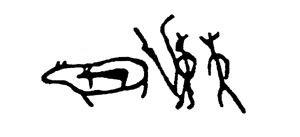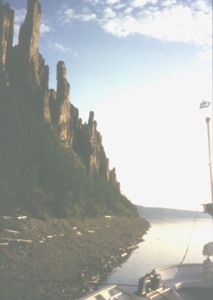
Origins of the Sakha (Yakut)
The origins of the Sakha or Yakut people are something of a mystery. It is apparent from their language and customs that they had not been in the country for more than two or three centuries before the Russians arrived there, yet they had conquered the whole region. It was also clear that they had been an advanced nation, but they had apparently lost their writing system and any written works completely. So only oral histories survived.
Influences in the culture and arts suggested links with traditions as far afield as the Celtic traditions of Western Europe. They had a similar clan system, and other cultural similarities. There are also cultural similarities with Buryat Mongols and with Central Asian, and other Turkic nations. The differences between Yakut and other Turkish languages suggest that it separted from the other Turkish languages as much as two thousand years ago. The Yakut language has changed little in the last five centuries.
From language and art (lions and camels for example) it was clear that they had once lived much further south, and many of the northern characteristics of their culture had been acquired when they had moved up the River Lena. Although local tribes were no match for the well armoured mounted calvalry of the Yakuts, they did know how to survive the extremely bitterly cold winters and the Yakutian culture had to adapt.
Genetic studies in 1986 of the characteristics of the Yakut people found many with European features - not surprizingly by that time, but also that the majority of the Yakut people had factor B17 in their blood which is only found in one other place. That is in Northern India. The DNA codes of the Sakha show a rare combination of antigens HLA-A1 and HLA-B17 that is also found in Indian DNA. No other mongoloid group has the HLA-A1 antigen. This indicates a definite link that the modern Sakha people came from the ancient Saka who ruled north-east India and Pakistan some two thousand years ago. (Buddha was a Saka prince).
There are also cultural links with Northern India - for example the köss - the distance travelled while a kettle of water comes to the boil - this is found in both places and others in central Asia.
However the Sakha people tend to have the central part of the face very long and other features which are the same found on the ancient skulls in archaeological sites like Diring Yuryakh. Either the Sakha people originated in this region, moved south, then back, or, more likely, came from the south and mixed with the locals.
Recent genetic studies show that the Yakut population is linked to Asian populations but not Central Asian. The Y chromosome shows origins more than 30,000 years ago in south east Asia, but also in East Europe, about 12-14,000 years ago.
It has been possible to find genetic material in frozen graves dated to about 400 years ago, and this indicates recent origins from South Asia, but also the mitochrondrial dna showed maternal origins from East Europe and West Asia, and Siberia. Which shows that the full history of the Sakha people is still not known.
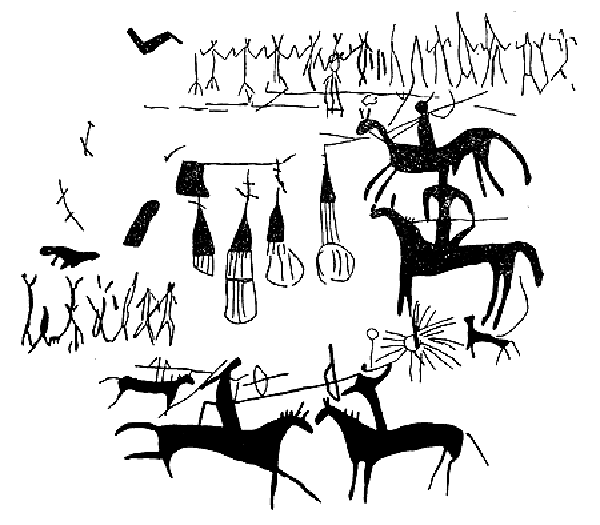
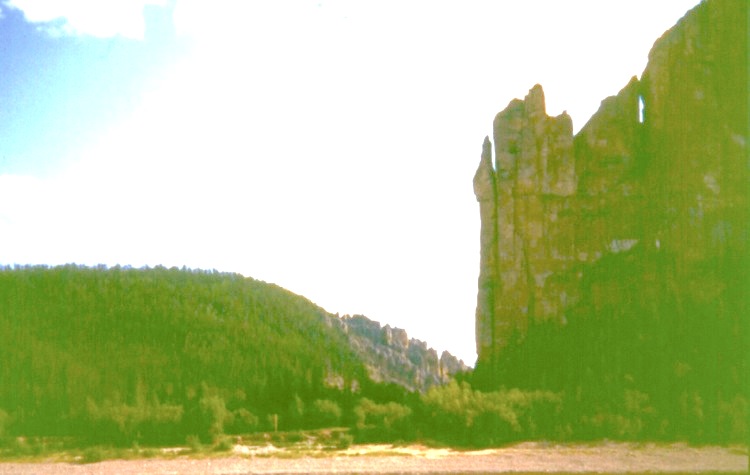 Rock drawings on the cliffs by the River Lena, show armed warriors on horseback with banners - the Sakha in their medieval armour - who arrived in the Middle Ages at the time populations were shifting due to climate changes and the expansion of the Mongol empire. Picture on the left is a copy of some of those drawings. The picture on the right is a sacred place by the Lena Pillars.
Rock drawings on the cliffs by the River Lena, show armed warriors on horseback with banners - the Sakha in their medieval armour - who arrived in the Middle Ages at the time populations were shifting due to climate changes and the expansion of the Mongol empire. Picture on the left is a copy of some of those drawings. The picture on the right is a sacred place by the Lena Pillars.
They tell their stories as epic poetry - the Olonkho.
The stories tell of superhuman heros in long epic poems.
The Sakha brought their sturdy little ponies and cattle up north. Their cows look much the same as English cows, but the ponies are a special ancient breed that can survive the cold winters. Recent studies of the genomes of domesticated Yakutian horses has shown that the current population of Yakutian horses followed the migration of the Yakut people into this region in the 13th to 15th centuries AD. The Yakutian horses would have adapted very quickly to the climate, with winter temperatures which could go below -70C. These horses was essential to their survival, needed for communication between the people on a such a vast territory, much of it above the Arctic Circle. Horses were present in Yakutia for at least 30,000 years, but these wild horses are not the ancestors of the Yakutian horses, which were brought in by the Yakuts when they moved into the region. More on recent archaeology on the Yakut (Sakha) horses.
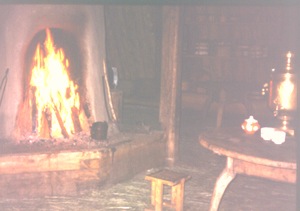
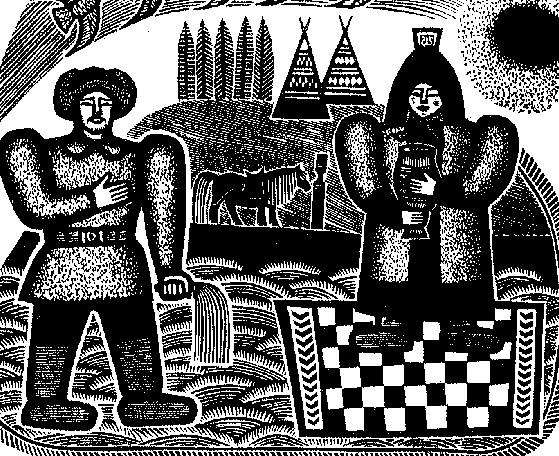 In winter they lived in a house called a balagan made of logs, plastered with mud and dung, with bark roofs covered in turf. You can still see these traditional houses as they have been constructed up to the present. Like traditional English houses one half was the house, the other (North) side was a barn for overwintering the livestock. The front door always faced East. More about this further on.
In winter they lived in a house called a balagan made of logs, plastered with mud and dung, with bark roofs covered in turf. You can still see these traditional houses as they have been constructed up to the present. Like traditional English houses one half was the house, the other (North) side was a barn for overwintering the livestock. The front door always faced East. More about this further on.
Inside the house was a hearth with chimney. Fur patchwork rugs covered the floor and the benches all round walls of the room. The picture on the right is from a woodcut from 1967 which shows a typical Sakha interior with the fur checked rug.
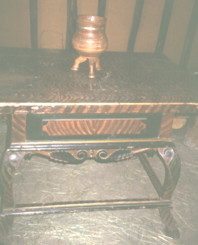 They were so fond of their horses that even their tables and pots had (and still have) horse-shaped legs.
They were so fond of their horses that even their tables and pots had (and still have) horse-shaped legs.
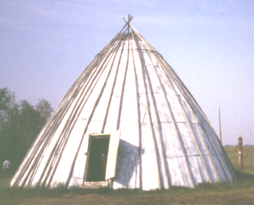 In summer they moved to a large tent called an Urasa. (or Uraha as small h in Sakha can be written as s)
In summer they moved to a large tent called an Urasa. (or Uraha as small h in Sakha can be written as s)
The picture shows a school wall painting in Zhigansk 1993, which shows four typical Sakha - toyon, lady, etc. holding the traditional choron - the wooden cups - which can also have horses legs shapes for their base, used to serve kumiss, and the three types of horses hitching posts - the Sergey - which are more spiritual monuments to the gods of the upper world. On them is the Yakut name for their country "Sakha Sirey" - also the name of a local newspaper, it is how the Sakha Republic (Yakutia) is referred to in Sakha (Yakut)
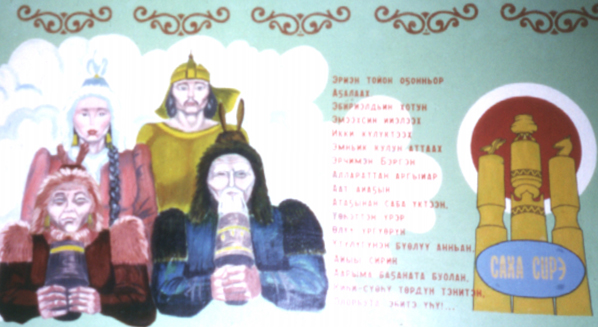
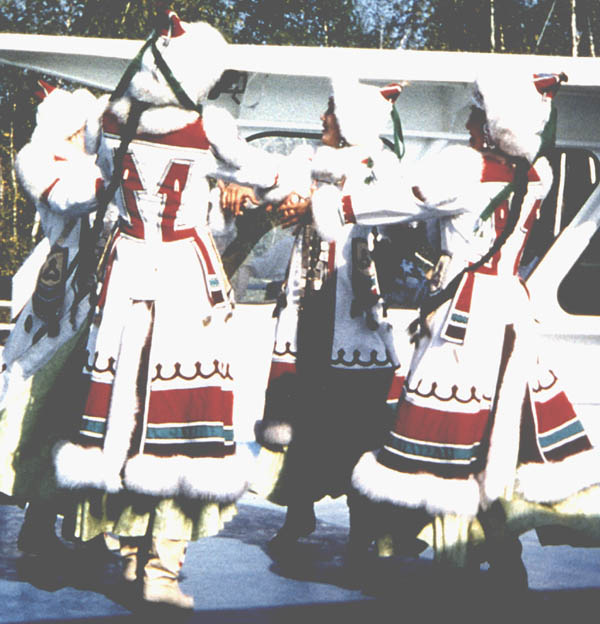 The clothes were heavily decorated with embroidery and silver jewrelry. Men wore silver belts and women wore big heavy necklaces, and headbands. They carried silver chatelaines from their belts, and also in summer a silver handled fly swat made from a horse tail. Their ponies were also caprisoned with embroidered clothes and silver saddles.
The clothes were heavily decorated with embroidery and silver jewrelry. Men wore silver belts and women wore big heavy necklaces, and headbands. They carried silver chatelaines from their belts, and also in summer a silver handled fly swat made from a horse tail. Their ponies were also caprisoned with embroidered clothes and silver saddles.
More on traditional Sakha clothes.
The people the Yakuts encountered when they moved up the River Lena, were the Yukagir the orginal inhabitants, and the Tungus (Evenk) from Manchuria and around Lake Baikal.
The Tungus/Evenk had arrived in the area only a few centuries before the Yakuts,about the 9th and 10th centuries from the area around and east of Lake Baikal and from Manchuria. They were reindeer herders. Reindeer are heavy on pasture and the Tungus/Manchurian reindeer herders spread out over all of central and Eastern Siberia in just a few centuries. Living in small groups formost of the year and spending very little time in any one place, the Tungus only had minor conflicts with local people.
The cultural effect was enormous however. The Tungus language and culture on local people and local dress and lifestyle on the Tungus.
The big clash came between Yakuts and Tungus. People with similar armour and weapon technology. Although the Tungus used reindeer to ride, even in battle, in place of horses.
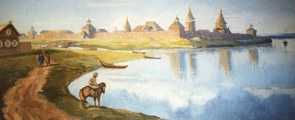 Treaties were eventually made, as the Tungus were nomadic through the taiga forests and tundra with their reindeer, and the Yakuts settled by the the meadows with their ponies and cattle. They called the River Lena - Sakhsara, and their main settlement upon it Sakhsary which the Russians renamed Yakutsk when they arrived in the 17th century
Treaties were eventually made, as the Tungus were nomadic through the taiga forests and tundra with their reindeer, and the Yakuts settled by the the meadows with their ponies and cattle. They called the River Lena - Sakhsara, and their main settlement upon it Sakhsary which the Russians renamed Yakutsk when they arrived in the 17th century
The Sakha (Yakut) Universe
The Yakutian house
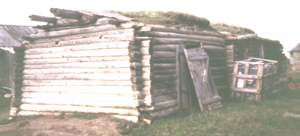 The traditional winter house, the balagan was half dwelling and half barn. They can still be seen today. But now they have outside winter toilets, and are supplied with water and electricity through above ground pipes which have to be climbed over as they cross the muddy paths. There were houses half dwelling half barn in England which still survive. They were originally built with a wood frame, filled with wicker covered plastered with mud and cow pats.
The traditional winter house, the balagan was half dwelling and half barn. They can still be seen today. But now they have outside winter toilets, and are supplied with water and electricity through above ground pipes which have to be climbed over as they cross the muddy paths. There were houses half dwelling half barn in England which still survive. They were originally built with a wood frame, filled with wicker covered plastered with mud and cow pats.
The Sakha had plenty of logs from the dense taiga forest to build their balagans, which were then plastered all over, roof too, with clay and cowpats. On the south side is the living quarters for people, on the north side for animals. The front door always faces the east. The small windows were glazed with ice in winter, and horse hair mesh or fishskin in summer.
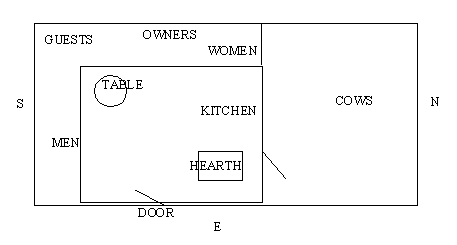 Inside, bunks are built into the south and west sides to use as seating by day and beds by night, with curtains and fur rugs. The south-west corner is the "best" corner, where guests were received and accomodated. In the "best" corner was a carved wooden table, with legs shaped like horses hooves. Some of these tables are very finely worked with inlays of different woods in patterns.
Inside, bunks are built into the south and west sides to use as seating by day and beds by night, with curtains and fur rugs. The south-west corner is the "best" corner, where guests were received and accomodated. In the "best" corner was a carved wooden table, with legs shaped like horses hooves. Some of these tables are very finely worked with inlays of different woods in patterns.
Next to this, facing the front door on the west side was the accommodation of the owners of the house. On the north side was the women's quarters. Also on the north side was the kitchen and a door to the barn part of the house. The clay chimney with hearth which served for cooking and heating was near the centre. The larger balagans had a separate room for the women and girls. And separate barns and stables all within a palisade, with the Sergey - the horses hitching post at the entrance.

Horses Hitching Posts
(the Sergey) are still found in front of main buildings, as monuments, war memorials, etc. Many are now concrete. They are more symbolic than somewhere to park your horse. The carvings had relevance. They may be topped by a model of the Choron - the ceremonial kumiss cup, or with a horses head, or a sort of crown, - it depends which god is being reached out to. They are most often in a set of three as in picture above.
Yakutian view of Yakutia
The whole country - Yakutia- now the Sakha Republic, was seen as aligned according to Sakha religous concepts. It was seen as a square or rather diamond shape with four corners.
- The North Corner, is the Bulun region - where the River Lena meets the Arctic Ocean. The port town of Tiksi is one of the main places here.
- The second corner is the East corner. This is on the Pacific Ocean - the Okhotsk sea, and is where we find the Kharbarovsk region and towns such as the port of Magadan.
- The third corner is the far west of Yakutia and is where Viluisk is and the main centre for diamond mining.
- The fourth corner is the south, and is the Upper Lena and the Baikal Inland Sea.
Rosa Bravina, then professor of anthropology at Yakutsk University and a white shamaness showed me the four directions of Yakutia on a map. When I pointed out that the borders of Yakutia no longer reached the Pacific Ocean or Lake Baikal, she said that they should do. In fact they did until Stalin annexed the gold mining regions.
Yakutian concepts of the Universe
The Yakut sagas - the olonkho - start with a feeling of endless space and time. From the ancient times there were three tribes of Gods:
- The Ayyy
the kind Creators
who were ruled over by Urun Ayyyt Toyon ( lit. Creator White Lord)
- Evil Spirits
the Behind Cloud deities
ruled over by the spirit master Uluu Toyon
- Demons - the Abaasy (or Abaahy as small h in Sakha can be written as s)
ruled over by Arsan Duolay.
The Upper World - Heaven, was created first, then the Lower World, then Earth in the middle. The Earth was round and surrounded by water. We live on Middle Earth. Above us is the Upper World - Heaven, below us, the Lower World.
The Upper World has nine levels - and all have their own different colours and properties.
The lower levels, near the earth, are blue. They have a blue sky and a constant wind. They are eternal dust and ice. Further up the middle sky is yellow and much brighter. The levels of heaven get lighter and lighter the higher they are above Earth, until the highest level is white. White is symbolic of the Upper Gods especially. The Sun is white - hence the national flag shows a white sun on a blue sky.
Each level of heaven has its own population of spirits and gods.
The first two layers are inhabited by evil spirits who send miseries like depression and criminal behaviour. For example when Blood God enters a man he makes him a murderer. Another of these gods makes people commit suicide. Suicides were buried without a coffin in a remote place because they had been possessed by an evil spirit. Another evil goddess turned women into prostitutes.
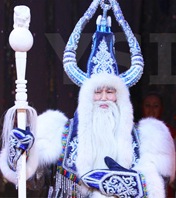 The higher levels of the sky were inhabited by nicer gods in a more pleasant environment. Each god was a protector of someone or something on Middle Earth. There is a God of Tragic Fate, and a God of Good Fortune for example, as well as gods and goddesses for ordinary things on earth like cattle. Our children answer for us.
The higher levels of the sky were inhabited by nicer gods in a more pleasant environment. Each god was a protector of someone or something on Middle Earth. There is a God of Tragic Fate, and a God of Good Fortune for example, as well as gods and goddesses for ordinary things on earth like cattle. Our children answer for us.
There are eight layers in the Lower World. Odd numbers are male, and have positive qualities. Even numbers are female and have negative qualities. So three is the number of happiness, male etc etc. but eight is a negative sort of number and female. The ideal family wished for by a married couple was nine boys and eight girls.
As you go down in the Underworld, below Middle Earth, each level becomes darker and darker. The lowest world is a deep red colour. It is the bleeding layer of fire - which you can see each morning and evening at dawn and sunset. Lurking in the Lower World are the gods and spirits for each disease. A recent arrival in these regions were the deities for venereal diseases. These were apparently unknown in North East Siberia until the Russians arrived in the 17th century.
Middle Earth - where we live, is unprotected. It is crossed by a black whirling tunnel (like an ox throat) and sucks eternal emptiness into itself. Into this tunnel shamans go and become unbeing. (You can see this black spot in the centre of your vision when short of oxygen. The whirling dance of the black shaman would produce the same effect.)
Unbeing for the shaman, is not death but a different state of being. But no one wanted to live in the middle world because of the black tunnel. So the Creators made someone to live there - ourselves.
Each person is made of good and kind things and evil things. The first people on Middle Earth were alert and keen. The more they developed, the more they were driven from nature. And now only the shaman can understand the mystery of nature and enter the entire world.
Every deity wanted to influence man, so man became the centre of the universe. If we do something in the wrong way we offend the spirits and they will not help us. So we have set rituals.
The Upper World is associated with men's creation, and horses. The Lower World is associated with women's creation and cows. In the Lower World the grass and trees are all made of iron. Everything is the opposite of the Upper World. Here in the middle world we have both men and women, both horses and cows.
The whole universe is connected by the World Tree. Its roots are in the Lower World, its branches are in the Upper World. The World Tree unites all three worlds. (The concept of the universal World Tree is all over the northern hemisphere and survives as the Christmas Tree).
There are four main Directions on Earth.
- The North Way leads to the Lower World
- The East Way leads to heaven and the kind gods
- The West way is the way of the evil spirits in heaven
- The South way is the way of the evil spirits in heaven.
The South Way leads to an unknown country where a god with six arms and six legs lives. This is similar to the India God Shiva and may be a survival from the past when ancestors of the Yakut inhabited northern India. Yakut people pray to this god.
The East is where the sun rises, and the day begins
The West is where the sun sets, and the evening begins. The shaman faces South and East to make kind blessings. Otherwise he faces West and North. Spring begins in the East. These are concepts found spread all over the north.
There are eight Directions altogether. As well as north, south, east and west, there is northwest, northeast, southwest and southeast.
The Summer festival began with the sunrise and with the kumiss ceremony. Shamans and women could not be present then.
The autumn holiday represents the borderline between summer and winter seasons. It is held at night in September. This holiday was organized by the shamans. They gave a blood sacrifice. The symbol of winter was the North direction and the Ox. First one horn of the ox falls down then the second horn, then the whole head, then spring comes. The South has positive attributes and is attractive but the north has negative attributes and is frightening. East and west are neutral.
To have a Good Life
for the Yakut people was to grow up, marry have children, property, see your children marry and have their own homes and families and do well and live past 70 in good health and when death comes it is quick and faced with the satisfaction that you have had a good life.
For a child to be born - the mother spirit of that child (ije-kut) is inserted into the top of the head of the future father by the heavenly deities (Ajyy) Ajyyhyt and Ijekhsit. Under the direction of the main heavenly god - Urung Aiyy Toyon. This mother spirt enters the woman's womb when they make love, to become the new baby. This was just one part of the new baby's soul or spirt (kut). Sakha mothers gave birth on the ground, as when the new born child touched the ground, the Earth spirit (Buor kut) entered. With the child's first cry, the Air Spirit (Sulyyn-kut) entered. The Earth Spirit symbolized the body, material things, the Air Spirit symbolized spiritual things.
You needed all three spirits for good health - if one was missing you were ill. Evil spirits or demons - the Abaahy, could steal or torture the mother spirit or the earth spirit. And the air spirit which wanders about during dreams, could be caught by evil spirits then, so a person could get ill then. The earth spirit remained near its person and if it was caught by evil spirits, you got ill and might die. The mother spirit never left the body, except when the other two spirits were tortured by demons. Diseases depended on what sort of evil spirit had stolen your spirit, and your spirit could be replaced by an evil spirit.
Animals also had spirits. Spirits looked like small bugs, usually too tiny to be seen easily and were distinctive.
A child was not considered as a person up to about the age of seven, because it was so easy for a child to be eaten up by even a small evil spirit. When a young child died they were not buried with the usual funeral ceremonies. A young child's body was was put into its cradle and hidden in the tomb of a relative. It was believed that the dead child's spirit turned into a bird - sometime later to return. One way of protecting children was to give them a protective name in those early years.
At about seven when a child could talk, learn and think, the child was fully human. They had acquired a new sort of spirit - the sur. This was the powers of thinking, brought by Uluu Toyon ruler of the evil spirits, but brought together with the kut by Ajyyhyt. (Some controversy over these beliefs). Trouble with the sur, depended on your kut. Could make you depressed, anxious, frightened.
Being grown up, meant getting married. Physical maturity meant social maturity. Marriage, children and property meant you were respected, and was your role in life as an adult. Your aim was to see your children grow up, do well, marry and give you grandchildren. After which life goes downhill, you gradually lose your abilities that you have acquired, and if you had fulfilled your life programme satisfactorily, could head for a respected old age (70 or more) and a "good" death.
With death, the Mother Spirit (Ije Kut) returns to the White Urung Ajyy-Toyon, the sur returns to the Great Uluu Toyon, the Earth Spirit (Buor Kut) remains with the body, the Air-Spirit (Salyyn Kut) spreads into the air. Kut and Sur were thought to return to their deities and exist there until they are placed in bodies again by the White Ajyy Toyon. Their destiny on the Earth is defined by Djylgha-Khaan and they are ecorted to Earth by Nalyyr-Ajyyhyt.
Dying too young, through disease, accident, murder or suicide, was a "bad" death. Evil spirits - the abaahy, cause the death and tortured the kut or body spirit so death was painful and miserable.
Evil spirits the abaahy, lived in all three worlds - Upper, Middle and Lower. Those of the Lower World specialized in different diseases, and formed gangs or clans associated with groups of diseases. The Middle World was haunted with spirits of the dead whose "kut" wanted to remain amongst the living. These ghosts were called "yor" (or eor). These evil spirits caused premature deaths through accidents or suicide, and could be attracted by a personal doing the wrong things, or being wished ill by someone.
The information on a Life and Death, is mainly from the article by Rosa Bravina "Life and Death according to the traditional beliefs of the Yakuts".
Yakut(Sakha) Months
Each year was counted as two years - a winter year and a summer year. This dual year system is found in other countries in the far north such as Iceland and Alaska, where there are climatic extremes. The winters are so dire, that people almost hibernated.
 The eleventh month was around March, Kulun Tutar , (kulun = foal, tutar = keep off, that is keeping the foal off its mother by tethering it, so the mare could be milked. The milk is made into kumiss for the summer kumiss festival. The picture (taken by Heather Hobden in 1993) shows cow pasture near a Yakut village. (You can see the polygonal pingos caused by the permafrost as the cracks in the earth show up with the different taller greener vegetation.)
The eleventh month was around March, Kulun Tutar , (kulun = foal, tutar = keep off, that is keeping the foal off its mother by tethering it, so the mare could be milked. The milk is made into kumiss for the summer kumiss festival. The picture (taken by Heather Hobden in 1993) shows cow pasture near a Yakut village. (You can see the polygonal pingos caused by the permafrost as the cracks in the earth show up with the different taller greener vegetation.)
The twelfth month is Muus Ustar - ice drifting month, when the ice breaks up on the rivers. Recent global warming has caused massive flooding as the arctic ice holds back the melting rivers and has to be broken up with exposives.
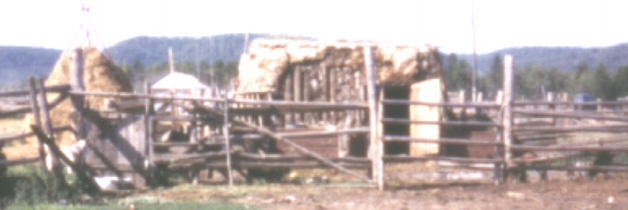 Picture shows part of a Yakut village. May is Yam Yja fish spawning month- people left their winter houses (the balagan) for summer tents of ornamental birch bark (the uraha). They still move to summer homes and you still see families camping along river banks in tepees or tents for summer fishing.
Picture shows part of a Yakut village. May is Yam Yja fish spawning month- people left their winter houses (the balagan) for summer tents of ornamental birch bark (the uraha). They still move to summer homes and you still see families camping along river banks in tepees or tents for summer fishing.
June is Bes Yja - Pine month. The pine sap wood was collected and in the winter made into flour. This was a substitute for grain which could not be grown so far north. A century ago they were still forced from lack of any suitable alternatives, to make the mortars to grind the sap wood from fresh cow dung over which water was poured and frozen to make it hard. But as the sides of the mortar were struck bits broke off and mixed with the flour.
July is Ot Yja - haymaking. Still done by hand. The ground is uneven and can be swampy.
August is Atyrd'akh Yja - Pitchfork or hay drying month. The round heaps of hay are collected into haystacks which had to be raised off the ground. When they could not get enough hay for the cows they were fed on fish which made the milk taste fishy and the tea taste awful. (Yakuts/Sakha same as the British like their tea with milk).
The months used to be measured exactly by the moon. Twelve lunar months are shorter than the solar year by about eleven days, so every three years an extra month was added to summer to bring the months back in line with the seasons.
September is Balagan yja, Balagan month when they returned to their winter houses - the balagans.
In the past, not much happened in winter as people survived on stores in their winter homes. October is Altynyy, November is Setinyi - December is Ahsynnyy, January is Tohsunnii, February the tenth month is Olunniu.
The summer of the Yakut calendar begins on 22nd May with the first cuckoo, and lasts three months until the 18th August. The summer is divided into three periods. Samaan saiyn, (Thanksgiving summer) - 22nd May to the 21st June. Ilge saiyn, (Beautiful summer) 22nd June to 21st July and Iye saiyn, (Mother summer), 22nd July to the 18th August).
 Beautiful summer is the hottest time of the year (it was 36 degrees when I was in Yakutsk in late July). It is also the time of thunder storms - which start forest fires in the taiga.
Beautiful summer is the hottest time of the year (it was 36 degrees when I was in Yakutsk in late July). It is also the time of thunder storms - which start forest fires in the taiga.
There are masses of flowering plants, producing fruit. There are roses and hawthorn. You walk through aromatic wormwood and hemp (see picture). Birds are in their nests. Fish are not only in the ocean, they come up the rivers. (Was fed salmon for nearly every meal including party fare, when I was there in July and August).
From the 12th June summer at its height. Medicinal plants are gathered each day, used for treatment by many doctors. It is possible to collect ripe berries, red currants, raspberries and strawberries. On Yakut estates there are special days for haymaking.
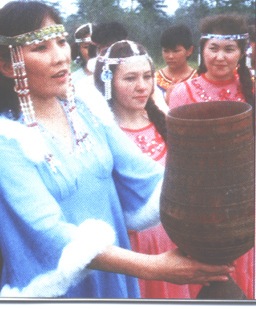 And then they hold the kumiss festivals. These are presided over by the white shamans and people dress up in their colourful traditional dress. The kumiss is made and dished out with traditional and sacred equipment, made mostly of wood and drunk from a turned and carved wooden cup called a choron. The carved decoration represents the sardana - the red lily which is the traditional flower of Yakutia and comes out in the spring. It is a popular girl's name.
And then they hold the kumiss festivals. These are presided over by the white shamans and people dress up in their colourful traditional dress. The kumiss is made and dished out with traditional and sacred equipment, made mostly of wood and drunk from a turned and carved wooden cup called a choron. The carved decoration represents the sardana - the red lily which is the traditional flower of Yakutia and comes out in the spring. It is a popular girl's name.
See also Time Before Clocks for the Yakut method of counting the days by the phases of the moon.
Fitting lunar months into the solar year and keeping up with the seasons
In the Yakut calendar, as mentioned, every three years an extra month was inserted after the hay-drying month, to bring the calendar back in line with the season. Such adjustments were necessary in all lunar calendars because the lunar months do not fit into the solar year. A year of twelve months is eleven days too short, and after three years the discrepancy is 33 days - over a month.
If this is not adjusted, the months fall badly out of line with the seasons after which they are named. So in most calendars where the months are fixed by the moon, every three years or so, there are 13 months instead of twelve. Alternatively there may be 13 months, then a month was omitted when necessary. The Sakha used to adjust their calendar by the autumn appearance of the Pleiades rising in the eastern sky.
The Shamans
Shamanism was gutted out in Europe by the 18th century under Christian persecution, but the missionaries had less impact on remote parts of Siberia. Despite persecution first by the Christian missionaries and the Tsarist government, and then under the Stalinist regime, the shamans survived. With the founding of the Russian Republic in 1991, came a great shaman revival. Shamanism was made the official religion of the Sakha Republic, and shamans have re-emerged in Evenkia, Tuva, Mongolia, and other parts of central and northern Asia. In 1992, there was a Shamans Conference in Yakutsk.
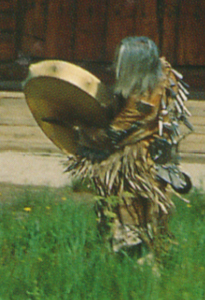 In Yakutia there are three levels of shamans. At the lowest level are the faith healers, and in modern Russia they are on television and the internet too - there are the greatest number of these. At middle level are the White Shamans. I have met some white shamans. They know how to perform and conduct the various festivals, such as the summer kumiss festival, and day to day rituals.
In Yakutia there are three levels of shamans. At the lowest level are the faith healers, and in modern Russia they are on television and the internet too - there are the greatest number of these. At middle level are the White Shamans. I have met some white shamans. They know how to perform and conduct the various festivals, such as the summer kumiss festival, and day to day rituals.
At the top level are the Black Shamans. These are the ones who wear the special magic costumes, collected by them together in special magic ceremonies and perform the special ceremonies called kamlanie. They have the power to invoke the deities on all levels of both the Upper and Under Worlds and travel to these worlds through a connecting tunnel when they are in the trance during the kamlanie. They preside over winter festivals and conduct their ceremonies at night. The current Yakut Black Shamans refuse to perform publicly saying it is their religion, not for tourists.
The word shaman is from the Evenk language (chaman or shaman), the Sakha word is Oyuun. A woman shaman is called a Utagan, which means fire (or hearth) woman. They can be more powerful than the men and could be very beautiful. (Well given magic powers a makeover would be first on my list too!)
Since everything was caused by spirits, diseases were attributed either to the invasion of an evil spirit or to the escape of one of the patient's own souls. (An individual has four or five souls presented at birth and crucial times in childhood by the appropriate deity).
The shaman would be called upon to diagnose the malady, then to effect the cure during ceremonies which may last several days. Young girls were not taken along to these ceremonies, as sometimes the spirits were a bit obscene. In these rituals the shaman, dressed in his magic clothes, beating his drum, sang and danced into a frenzy (when he had to be tied up). Finally the shaman fell unconscious into a trance when he was possessed by his spirit familiar which took the form of an animal or bird. In this shape, the shaman's spirit travelled to the places in the universe where the appropriate spirits or gods could be found for the information required, and a missing soul was searched for, or aid obtained in exorcising an evil spirit. (Rosa Bravina said that her notes at a ceremony - which lasted three nights, took 400 pages.)


 Rock drawings on the cliffs by the River Lena, show armed warriors on horseback with banners - the Sakha in their medieval armour - who arrived in the Middle Ages at the time populations were shifting due to climate changes and the expansion of the Mongol empire. Picture on the left is a copy of some of those drawings. The picture on the right is a sacred place by the Lena Pillars.
Rock drawings on the cliffs by the River Lena, show armed warriors on horseback with banners - the Sakha in their medieval armour - who arrived in the Middle Ages at the time populations were shifting due to climate changes and the expansion of the Mongol empire. Picture on the left is a copy of some of those drawings. The picture on the right is a sacred place by the Lena Pillars.
 In winter they lived in a house called a balagan made of logs, plastered with mud and dung, with bark roofs covered in turf. You can still see these traditional houses as they have been constructed up to the present. Like traditional English houses one half was the house, the other (North) side was a barn for overwintering the livestock. The front door always faced East. More about this further on.
In winter they lived in a house called a balagan made of logs, plastered with mud and dung, with bark roofs covered in turf. You can still see these traditional houses as they have been constructed up to the present. Like traditional English houses one half was the house, the other (North) side was a barn for overwintering the livestock. The front door always faced East. More about this further on.
 They were so fond of their horses that even their tables and pots had (and still have) horse-shaped legs.
They were so fond of their horses that even their tables and pots had (and still have) horse-shaped legs. In summer they moved to a large tent called an Urasa. (or Uraha as small h in Sakha can be written as s)
In summer they moved to a large tent called an Urasa. (or Uraha as small h in Sakha can be written as s)

 The clothes were heavily decorated with embroidery and silver jewrelry. Men wore silver belts and women wore big heavy necklaces, and headbands. They carried silver chatelaines from their belts, and also in summer a silver handled fly swat made from a horse tail. Their ponies were also caprisoned with embroidered clothes and silver saddles.
The clothes were heavily decorated with embroidery and silver jewrelry. Men wore silver belts and women wore big heavy necklaces, and headbands. They carried silver chatelaines from their belts, and also in summer a silver handled fly swat made from a horse tail. Their ponies were also caprisoned with embroidered clothes and silver saddles. Treaties were eventually made, as the Tungus were nomadic through the taiga forests and tundra with their reindeer, and the Yakuts settled by the the meadows with their ponies and cattle. They called the River Lena - Sakhsara, and their main settlement upon it Sakhsary which the Russians renamed Yakutsk when they arrived in the 17th century
Treaties were eventually made, as the Tungus were nomadic through the taiga forests and tundra with their reindeer, and the Yakuts settled by the the meadows with their ponies and cattle. They called the River Lena - Sakhsara, and their main settlement upon it Sakhsary which the Russians renamed Yakutsk when they arrived in the 17th century The traditional winter house, the balagan was half dwelling and half barn. They can still be seen today. But now they have outside winter toilets, and are supplied with water and electricity through above ground pipes which have to be climbed over as they cross the muddy paths. There were houses half dwelling half barn in England which still survive. They were originally built with a wood frame, filled with wicker covered plastered with mud and cow pats.
The traditional winter house, the balagan was half dwelling and half barn. They can still be seen today. But now they have outside winter toilets, and are supplied with water and electricity through above ground pipes which have to be climbed over as they cross the muddy paths. There were houses half dwelling half barn in England which still survive. They were originally built with a wood frame, filled with wicker covered plastered with mud and cow pats. Inside, bunks are built into the south and west sides to use as seating by day and beds by night, with curtains and fur rugs. The south-west corner is the "best" corner, where guests were received and accomodated. In the "best" corner was a carved wooden table, with legs shaped like horses hooves. Some of these tables are very finely worked with inlays of different woods in patterns.
Inside, bunks are built into the south and west sides to use as seating by day and beds by night, with curtains and fur rugs. The south-west corner is the "best" corner, where guests were received and accomodated. In the "best" corner was a carved wooden table, with legs shaped like horses hooves. Some of these tables are very finely worked with inlays of different woods in patterns.
 The higher levels of the sky were inhabited by nicer gods in a more pleasant environment. Each god was a protector of someone or something on Middle Earth. There is a God of Tragic Fate, and a God of Good Fortune for example, as well as gods and goddesses for ordinary things on earth like cattle. Our children answer for us.
The higher levels of the sky were inhabited by nicer gods in a more pleasant environment. Each god was a protector of someone or something on Middle Earth. There is a God of Tragic Fate, and a God of Good Fortune for example, as well as gods and goddesses for ordinary things on earth like cattle. Our children answer for us. The eleventh month was around March, Kulun Tutar , (kulun = foal, tutar = keep off, that is keeping the foal off its mother by tethering it, so the mare could be milked. The milk is made into kumiss for the summer kumiss festival. The picture (taken by Heather Hobden in 1993) shows cow pasture near a Yakut village. (You can see the polygonal pingos caused by the permafrost as the cracks in the earth show up with the different taller greener vegetation.)
The eleventh month was around March, Kulun Tutar , (kulun = foal, tutar = keep off, that is keeping the foal off its mother by tethering it, so the mare could be milked. The milk is made into kumiss for the summer kumiss festival. The picture (taken by Heather Hobden in 1993) shows cow pasture near a Yakut village. (You can see the polygonal pingos caused by the permafrost as the cracks in the earth show up with the different taller greener vegetation.) Picture shows part of a Yakut village. May is Yam Yja fish spawning month- people left their winter houses (the balagan) for summer tents of ornamental birch bark (the uraha). They still move to summer homes and you still see families camping along river banks in tepees or tents for summer fishing.
Picture shows part of a Yakut village. May is Yam Yja fish spawning month- people left their winter houses (the balagan) for summer tents of ornamental birch bark (the uraha). They still move to summer homes and you still see families camping along river banks in tepees or tents for summer fishing. Beautiful summer is the hottest time of the year (it was 36 degrees when I was in Yakutsk in late July). It is also the time of thunder storms - which start forest fires in the taiga.
Beautiful summer is the hottest time of the year (it was 36 degrees when I was in Yakutsk in late July). It is also the time of thunder storms - which start forest fires in the taiga. And then they hold the kumiss festivals. These are presided over by the white shamans and people dress up in their colourful traditional dress. The kumiss is made and dished out with traditional and sacred equipment, made mostly of wood and drunk from a turned and carved wooden cup called a choron. The carved decoration represents the sardana - the red lily which is the traditional flower of Yakutia and comes out in the spring. It is a popular girl's name.
And then they hold the kumiss festivals. These are presided over by the white shamans and people dress up in their colourful traditional dress. The kumiss is made and dished out with traditional and sacred equipment, made mostly of wood and drunk from a turned and carved wooden cup called a choron. The carved decoration represents the sardana - the red lily which is the traditional flower of Yakutia and comes out in the spring. It is a popular girl's name. In Yakutia there are three levels of shamans. At the lowest level are the faith healers, and in modern Russia they are on television and the internet too - there are the greatest number of these. At middle level are the White Shamans. I have met some white shamans. They know how to perform and conduct the various festivals, such as the summer kumiss festival, and day to day rituals.
In Yakutia there are three levels of shamans. At the lowest level are the faith healers, and in modern Russia they are on television and the internet too - there are the greatest number of these. At middle level are the White Shamans. I have met some white shamans. They know how to perform and conduct the various festivals, such as the summer kumiss festival, and day to day rituals.